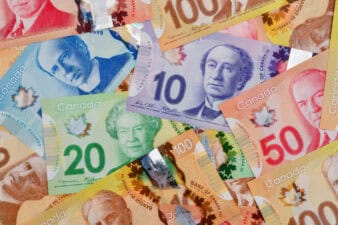The news about Trump Tariffs moved at warp speed over the weekend, with Donald Trump reversing his 145% tariff on Chinese electronics on Friday, then partially “re-reversing” the decision on Saturday, telling his followers to expect new tariffs in a month. He also clarified that Chinese electronics remained under a 20% “fentanyl tariff.”
Despite the later reversal of Trump’s reversal, China scored a big win over the weekend, with tariffs on much of its U.S. exports being lowered from 145% to 20%.
Sadly, it was a different story in Canada. Though our own tariff debacle has been eclipsed by China’s in international news, many of our goods are still being tariffed by Trump’s administration. These include cars, steel, aluminum, and others. It might seem strange for Donald Trump to offer tariff relief to China but none to its historically closest ally. On close inspection, though, the situation is even weirder than that.
A massive increase in uncertainty
As Donald Trump’s Saturday posts indicated, China is not actually getting a permanent reduction on the tariff rate it faces. It is instead having 145% tariffs on one category of goods reduced to 20% before a different category of tariff applies. Although the move will reduce the tariff rate on many Chinese exports over the next month–provided Trump doesn’t flip-flop again — it will arguably create an even bigger problem: uncertainty.
Uncertainty is very costly to businesses and governments because it forces them to invest more in contingency planning, as well as in supply chain components needed to carry out contingency plans if necessary.
Let’s say you’re a country, and your largest trading partner is changing its trade policies every day. One day, the tariff rate is 10%; the next, it’s 20%; the day after that, it’s 300%, and so on. You have to decide whether you will sell to this country or another one that is more costly to sell to, provided the first country’s tariff rate remains below 30%. Because of the uncertainty about where the tariff rate will fall, you need to invest in the infrastructure required to sell to both countries. This may prove costlier than simply paying a predictable 10% tariff.
This is the situation most of the world — especially China — faces with Trump tariffs today. In Canada, however, we face 25% tariffs on many categories of goods. That makes the situation comparatively manageable — unless, of course, Trump starts flip-flopping on us, too!
Investing for tariffs
If you’re wondering where to put your money amid all this tariff craziness, a good idea is Guaranteed Investment Certificates (GICs). They are boring, and their returns barely beat inflation, but they are very low risk. In a time of high uncertainty, low-risk assets make sense.
I don’t mean to say that you should abandon stocks altogether. Index funds can make a lot of sense, albeit in lower portfolio weightings than you’d hold them at in normal times.
Take iShares S&P/TSX Capped Composite Index Fund (TSX:XIC), for example. It’s a fund built on the TSX Composite Index. The TSX index consists of 240 stocks, and XIC actually holds about 220 of them. So, XIC represents its underlying index fairly well. The fund also has a very low 0.05% management fee and high liquidity/trading volume. So, when you own it, you don’t lose much money to market makers and their hidden “spread fees.” Overall, it’s a good choice.
 Don't Miss AI's Third Wave
Don't Miss AI's Third Wave








